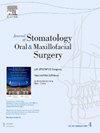不同手术方式下颧骨种植体与骨的三维接触面积百分比比较研究:临床和生物力学视角。
IF 1.8
3区 医学
Q2 DENTISTRY, ORAL SURGERY & MEDICINE
Journal of Stomatology Oral and Maxillofacial Surgery
Pub Date : 2024-11-14
DOI:10.1016/j.jormas.2024.102148
引用次数: 0
摘要
背景:对于骨质严重萎缩的老年患者来说,颧骨种植体,无论是单独使用还是与牙种植体结合使用,都是一种可行的咬合修复手术选择。本研究旨在探讨在不同手术方法下,颧骨种植体与牙槽骨之间的三维接触面积对生物力学的影响:利用10名严重骨萎缩患者的锥形束计算机断层扫描(CBCT)图像,我们重建了三维上颌骨模型,并创建了相应的三维颧骨种植体模型。根据每位患者颧骨种植体的位置和角度,我们采用了两种不同的手术方法(颌外或窦内方法)。计算了三维骨与种植体接触百分比(BIC%),并进行了非线性接触有限元分析,以评估两种手术方法的三维BIC%与周围骨应力之间的关系:在颧骨种植手术中,颌外入路法(57.63%)和窦内入路法(56.49%)的全骨(包括皮质骨和松质骨)三维BIC%相似(P=0.425)。相反,与颌外入路相比,窦内入路在皮质骨接触方面(28.08%)显示出更高的 3D BIC%(21.92%)(P=0.011)。窦内入路法的三维BIC%与高骨应力之间的相关性更强,这可能是由于皮质骨接触面积增大所致:结论:窦内入路可降低骨应力,骨应力与 3D BIC% 之间的相关性更强,尤其是在皮质骨接触部位。重要的是,颧骨种植体周围皮质骨的覆盖面积极大地影响了颧骨种植体的生物力学性能。本文章由计算机程序翻译,如有差异,请以英文原文为准。
Comparative study of 3D contact area percentage between zygomatic implant and bone in different surgical approaches: clinical and biomechanical perspectives
Background
Zygomatic implants, either alone or in combination with dental implant placement, have emerged as a viable surgical option for elderly patients with severe bone atrophy for occlusal restoration. This study aims to examine the biomechanical impact of the three-dimensional contact area between zygomatic implants and bone on biomechanics under different surgical methods.
Material and Methods
Using Cone Beam Computed Tomography (CBCT) images from 10 patients with severe bone atrophy, we reconstructed 3D maxillary bone models and created corresponding 3D zygomatic implant models. Two distinct surgical methods (extramaxillary or intrasinus approaches) were employed based on the position and angle of the zygomatic implant for each patient. The 3D bone-to-implant contact percentage (BIC%) was calculated, and finite element analysis with nonlinear contact was conducted to assess the relationship between 3D BIC% and surrounding bone stress for both surgical methods.
Results
The 3D BIC% of extramaxillary approach (57.63 %) and intrasinus approach (56.49 %) for total bone (including cortical and cancellous bone) was similar (P = 0.425) in zygomatic implant surgery. In contrast, the intrasinus method exhibited higher 3D BIC% in cortical bone contact (28.08 %) compared to the extramaxillary approach (21.92 %) (P = 0.011). The correlation between 3D BIC% and high bone stress was stronger in the intrasinus approach, likely due to increased contact area in cortical bone.
Conclusion
The intrasinus approach led to lower bone stress and a more robust correlation between bone stress and 3D BIC%, particularly in cortical bone contact. Importantly, the coverage area of cortical bone surrounding the zygomatic implant significantly influenced biomechanical performance of the zygomatic implants.
求助全文
通过发布文献求助,成功后即可免费获取论文全文。
去求助
来源期刊

Journal of Stomatology Oral and Maxillofacial Surgery
Surgery, Dentistry, Oral Surgery and Medicine, Otorhinolaryngology and Facial Plastic Surgery
CiteScore
2.30
自引率
9.10%
发文量
0
审稿时长
23 days
 求助内容:
求助内容: 应助结果提醒方式:
应助结果提醒方式:


